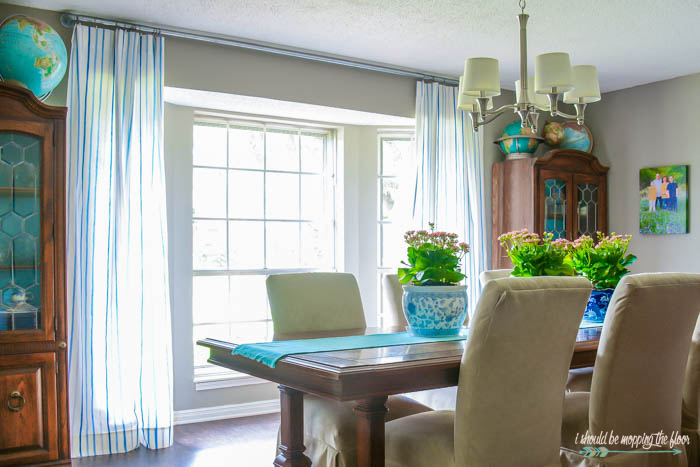This post for a DIY Plumbing Pipe Curtain Rod contains affiliate links. I make a small portion when these links are used, at no additional cost to you.
Our DIY Plumbing Pipe Curtain Rod worked out so well in our son's room, that we've now installed similar ones in four other rooms in our home. These make for fantastic extra long rods since they do not bow in the middle and can span the widest windows in your home. Come see our complete tutorial for this DIY Plumbing Pipe Curtain Rod below.
As we work on the different rooms in this ol' house of ours, we have learned that there are definitely quirks. For instance, the four windows (well, I guess *technically* it's four sets of three windows...meaning twelve windows) across the front of the house are all in this off-beat bay-style window. I say off-beat because these little areas have their own ceilings. While blinds would work, I loathe dusting blinds more than I loathe mopping. Exactly. So, we needed a new solution. This was actually our second solution. Our first one went over like an elephant pole vaulting. We crashed and burned on it. But check out how this plumbing pipe curtain rod worked perfectly for our situation (and see what blew up on us, too!).
DIY Plumbing Pipe Curtain Rod
UPDATE (04/28/21): I wanted to tell you that we're five years down the road from when we initially installed this plumbing pipe curtain rod in our son's room. It is still in there and functioning well for us. And as I mentioned above, we have since installed this same system in four other rooms in our home.
I'm also sharing my pros and cons for this particular set up below. There are a couple of hiccups that may take some getting used to with a system like this in place. But as you can see from the above photo, we have a weird window set up. And that same set up is in four rooms of our home. So, this plumbing pipe curtain rod has been the best solution for our needs. I truly can't handle a sagging curtain rod and these will never do that.
Here's how the same plumbing pipe curtain rod set up looks in our formal dining room (above). I just recently made those Laura Ashley drapes you see hanging in here, too. They're one of my favorite sets of window treatments with how light and bright they keep the space.
We also have this rod system in our guest room (pictured above). This room has the same bay windows on one wall, but a smaller window on a different wall. We just used a smaller pipe for this window. To give it a more dressed up look, I spray painted the entire rod and hardware gold. See how I made the No-Sew Polka Dot Curtains here.
Here's how the same plumbing pipe curtain rod set up looks in our formal dining room (above). I just recently made those Laura Ashley drapes you see hanging in here, too. They're one of my favorite sets of window treatments with how light and bright they keep the space.
Pros of a Plumbing Pipe Curtain Rod
- It can be used across an extra wide window or set of windows without worry of bowing or sagging.
- You can hang multiple sets of drapery panels on these rods without weighing them down (there are eight panels hung on our rod in our living area).
- It's a super sturdy and heavy-duty set up: perfect for kids' rooms.
- These rods function so well and last for years.
- The fun, industrial look adds a bit of interest to a space.
This is a previous look in our vintage guest bedroom, before I spray painted the rods.
Cons of a Plumbing Pipe Curtain Rod
- The rod requires a bit of a heavy-duty installation (you'll see what I mean in the tutorial below). And if you don't have direct studs to drill your connections into, you'll definitely need to use heavy-duty anchors. It can be a 2-3 person job, depending on how long your rod is.
- The biggest con to us is that we can't change out the actual drapery rings on the rod, at least not easily. Once you have connected your rod to the wall, it's not easy to pull it back down again. Your rings must be in place before you attach the rod to the wall. If you ever want to change them out or even add more rings to the rod, you have to take the entire thing down and start over. This wasn't a major issue until our son pulled too hard on his drapes and actually broke a couple of his rings. It's not the end of the world and we kind of fixed it with some clever wiring, but yeah. It's the biggest con to us. But, it wasn't a big enough deal to prevent us from installing more of these rods in the rest of the house.
- Sometimes the rings don't slide as easily as we'd prefer. We have found a fix for this, though. In our dining room, we bought rings that weren't coated with a slick finish, so they didn't slide open and closed with curtains very well...they'd get hung up. We sprayed a cloth with WD-40 and ran the cloth along the rod (carefully avoiding the drapes). This worked perfectly and the drapery rings now fly across the rod.
- One last con, that you may have noticed in the photo of the green guest bedroom is that the pipes are a fixed length (unless you own a fancy machine that can cut and rethread plumbing conduit, which gets very costly). This wasn't a huge deal to us, but it is something to be aware of.
The above is what our son's room looked like before using the plumbing pipe curtain rod. I thought I was all kinds of smarty pants when I stumbled onto this wire curtain rod system at the big blue store with four bright yellow letters on it (rhymes with eye-hee-ahh). Never mind the ridiculous drapery length here...I truly did have big plans on hemming these. I mean there's puddling and then there's just a hot mess. Pretty sure we were way beyond the hot mess line with these. I digress.
We installed the wire system...and by we, I mean my husband and son. It was okayish. But then, the tension would loosen. And we had annoying slack in the line to where it always looked so messy. Then we'd go to tighten the tension and THIS would happen (hand to head):
We'd tighten the line and the base poles would literally start pulling the drywall off the wall. So one day, in a fit of craziness, I ripped them all down (heh, heh...not like it was hard to pull them right out of the wall). I knew if I left them, I'd just deal with the curtains in all their dysfunction. If I ripped them down, I absolutely had to put something else up that worked.
So to the hardware store we went to solve our problem. Everyone was delighted to join my mayhem. Not.
Supplies for a Plumbing Pipe Curtain Rod
Head to the plumbing section of your hardware store for all of the below pieces (they are listed out underneath the photo).
Here's what we used. And just to be clear, what we should have done was refer to one of the other tutorials like this out in the blog world first. Nah, we winged it. And had to make multiple trips to the hardware store to take back wrong fittings in exchange for right ones. Multiple. Trips.
To save you multiple trips to the hardware store...here's our little guide.
Plumbing Pipe Curtain Rod Components:
- A - plumbing pipe (must be plumbing pipe and not electrical conduit), these come in 5 and 10 foot lengths (which worked out perfectly for us). However, if you need a smaller or different size, the hardware store folks can cut and rethread your pipe for you.
- B - plumbing flange (you'll need two per rod), these are what attach the pipe to the wall
- C - nipple connector (I promise that's its official term)
- D - "T" connector...this is only if you're connecting two sections of pipe for a really long window (you'll also need a third flange).
- We didn't use this part in our son's room, but it was necessary in the living room with our larger set up.
- E - elbow joint...be sure to get the kind that is threaded on the INSIDE on BOTH ends (this may have been one of our trips back to the hardware store)
- You'll also need bolts and hardware for connecting your pipe to the wall (see below how this works, what you will need for this step will all depend on your type of walls/studs).
- Depending upon where your wall's studs are located, you may also need anchors.
- Other items needed: wrench, screwdriver, drill, socket set
- drapery rings
- We like these kind from Amazon. They're practically the same finish as the plumbing pipe, so they look nice together.
Putting Your Plumbing Pipe Curtain Rod Together
You'll actually put the whole thing together on the ground ahead of time (rings, pipe, and even the drapes, although those can go up after the rod is in place). Just connect all of your pieces together as pictured in the image above.- Connect a flange (D) to a nipple connector (C).
- Attach an elbow (B) to the other end of your nipple connector (C).
- Attach the other end of your elbow rod (B) to the plumbing pipe (A)
- If you are installing an extra-long rod that requires more than one pipe, you'll connect them in the middle with a "T" connector, as I showed you in the parts photo. To that "T" connector, you'll add another nipple connector and a third flange.
- After you assemble one side of the rod, slip your curtain rings (and drapery panels, if desired) onto the rod.
- After your curtain rings are in place, assemble your other end of fittings.
- If you're doing the longer rod, with the "T" connector in the middle, you'll assemble one end of the rod, add your curtain rings, assemble the middle section, add another rod and more curtain rings, and then assemble the last end of the rod.
Attaching the Plumbing Pipe Curtain Rod to the Wall
This next step is definitely a two person job. If you're doing the extra long rod, with the additional fitting in the center, it's easier to have three people so everything can be held up at the same level while attaching to the wall.- Hold your rod up to your window (or up to the ceiling, where I prefer to hang my curtain rods) and mark the holes through the flange on both ends onto your wall.
- Pull your curtain rod down and pre-drill your holes in the wall. We lucked out in that we hit studs, so we didn't need anchors. But, if you don't hit a stud, you will need anchors for these...they are way too heavy.
- After we were predrilled, we put the rod in place and used large bolts to attach it to the wall. A socket set really comes in handy here.
The whole project is not nearly as difficult as it may seem...if anything this is easier than a standard curtain rod. It just takes some finessing with the weight and length of the rod.
Just to be up front...these aren't completely cheaper than curtain rods you'd buy at the store. I'd estimate about $40 for this set up. BUT, they are a lot more durable and do not bow in the middle or need a fitting to prevent bowing.
More Creative Curtain Rod Ideas
- I love Michael's Forged Nail Curtain Rod over at Inspired By Charm. He seriously has the most creative ideas.
- This Rope Curtain Rod from Mandi over at Vintage Revivals has a really cool texture to it.
- And Less Than Perfect Life of Bliss used a Painted Branch as a Curtain Rod. It's seriously fantastic.

Would you ever put a Plumbing Pipe Curtain Rod in your home? Be sure to check out our son's finished Preteen Bedroom, too. I also have a tutorial on how I created the DIY Industrial Light Fixture in the corner.





















Love your new rods and drapes. Sometimes you just have to take action and then fix it. At least that is my way.
ReplyDeleteBev
Thank you so much, Bev! Yes, that's definitely my way, too! ;) Appreciate you stopping by. xoxo
DeleteLove the industrial style. Thanks for sharing at the Inspiration Spotlight party. Pinned & shared. See you again soon.
ReplyDeleteThank you so much, Theresa! That is very much appreciated. xoxo
DeleteI made some to go around my hot water heater. Unfortunately they sag at the elbow, and I need some sort of way to anchor them (I am guessing to the ceiling) any ideas?
ReplyDeleteHi Alasandra! Yes, I would anchor to the ceiling using either molly bolts or some type of drywall/ceiling anchors. Did your flange go into your surface properly?
Delete